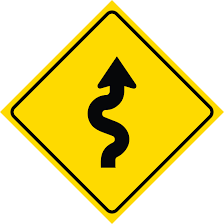03.21.2019: One Lesson of Math - Polynomials, 5/5: Graphs of Polynomial Functions
- Steven C. Mills

- Mar 21, 2019
- 4 min read

Today's soundtrack is Alter Bridge: AB III. These guys show the world what rock is supposed to sound like. Like I've mentioned before, I've been a fan of Creed for a long time; after Creed broke up, their drummer, their original bassist, and their guitarist, Mark Tremonti, joined forces with singer Myles Kennedy. Alter Bridge rose like the phoenix from the ashes of Creed, and the world is a better place for it.
This morning, I'm learning how polynomial equations relate to polynomial functions and their graphs.

There are several characteristics of polynomial functions and their graphs that we must recognize:
They are continuous
They have smooth curves (no "hairpin turns")
They will have a maximum of n-1 curves
n represents the polynomial's degree
We can state this another way:
They will have a maximum degree of "curves+1".
When graphing a function, there are a couple of rules to keep in mind:
Start on the left; end on the right
Recognize that "up" and "down" refer to positive and negative sides of the y-axis
So if we are told that a graph "starts 'up'," its leftmost arm points up to infinity
We talked yesterday about the different ways that we can categorize polynomials, including by their degree and leading coefficient. Today, we'll look into that concept further, then expand on it.
The degree (highest exponent) tells us the basic shape of the polynomial
If the degree is even, the function will start and end facing the same direction (up and up, or down and down)
If the degree is odd, the function will end facing the opposite direction that it started (up and down, or down and up)
The leading coefficient tells us which direction the polynomial goes
A graph with a positive leading coefficient will always end up
A graph with a negative leading coefficient will always end down
Now that we know the basic shapes we are creating, let's get down to brass tacks (gotta figure out some pun where we dance to the soundtrack of brass instruments being charged a sales tax) and figure out WHERE on the graph we should put them.
Dude, where's my function
Y-intercept
The y-intercept is simply the constant of the function. We can prove this by substituting 0 for x in any polynomial and solving for y. Even if we find a polynomial in factored form, we can determine its y-intercept by multiplying together the constants of each factor.
X-intercept(s)
The x-intercepts are found by substituting 0 for y, factoring, and solving for x.
Multiplicity
Sometimes we may have multiple identical factors, which we call multiplicity. These can only be identified when a polynomial is completely factored. We say that a factor has a multiplicity of n, with n representing the exponents next to the factor. Factors with multiplicity have an important role to play in how the graph is shaped.
Singular multiplicity (no exponent)
The graph blasts through the x-axis like a 17-year-old in a rented Lamborghini going through a stale amber
Even multiplicity (multiplicity of 2, multiplicity of 346, etc.)
The graph touches the x-axis at the coordinate, then bounces back off like it's hot. We call the bouncing-off point a "tangent."
Odd multiplicity (multiplicity of 3, multiplicity of 431, etc.)
The graph does a sick grind on the x-axis at the coordinate, then slides off, crossing the x-axis at what we call the "inflection point," and continues on its way through the hangar, trying to find the rest of the letters to get the S-K-A-T-E combo in less than two minutes.
Highest-degree term
Sometimes, the equation we are working with isn't in standard form. Maybe it's in factored form. Rather than going through the whole distributive factors thing for every single set of factors, we can just multiply all of the variables (including their coefficients) together to find the highest term. As I mentioned just above the picture of the brass tacks, the degree and the coefficient work together to tell us where the graph ends and how many curves there are, so this step is important!
Domain and Range
Domain
Will always be x ∈ ℝ
Range
If the degree is odd, will be y ∈ ℝ
If degree is even, will be y ≤ x or y ≥ x, with x representing the maximum or minimum y-coordinate of the graph
Absolute coordinates
Graphs with an even degree will have an absolute minimum or maximum point (which one it is depends on whether the highest coefficient is positive or negative).
Relative Coordinates
Maximum and Minimum
Relative maximum
Not including infinity or any absolute coordinates, the highest y-values of the graph
Relative minimum
Not including infinityor any absolute coordinates, the lowest y-values of the graph
Intervals
We identify in which areas f(x) ≥ 0, and in which areas f(x) ≤ 0
Positive y-values
What x-values produce positive y-values?
Negative y-values
What x-values produce negative y-values?
End Behaviour
These are the two points on the graph where it continues on into infinity, not turning any more
Let's go ahead and bundle this whole thing up nicely into a "how-to" list.
How to graph a polynomial
Find a root, then factor completely
Find zeros, then mark on graph
Find highest-degree term
Determine where graph starts and ends
Determine multiplicity of zeros
Graph
That's it for this unit on polynomials! In the next unit, we'll be learning about EXPONENTS AND LOGARITHMS!
Those of you who were paying attention in the section about multiplicity will know what I'm showing you here!





Comments